Los principiantes a menudo nos preguntan sobre cómo pasar sus sitios web a SSL o HTTPS. Los términos pueden sonar demasiado técnicos, pero en realidad es muy fácil de hacer.
HTTPS en la URL de un sitio web significa que utiliza un protocolo seguro de transferencia de datos mediante la instalación de un certificado SSL. Esto es importante porque la mayoría de los navegadores modernos muestran advertencias para los sitios web que no utilizan HTTPS.
Por suerte, la mayoría de las empresas de alojamiento fiables y WordPress hacen que sea muy fácil proteger su sitio web.
En este artículo, le mostraremos cómo mover su WordPress de HTTP a HTTPS añadiendo un certificado SSL. No te preocupes si no sabes lo que es SSL o HTTPS. También se lo explicaremos.
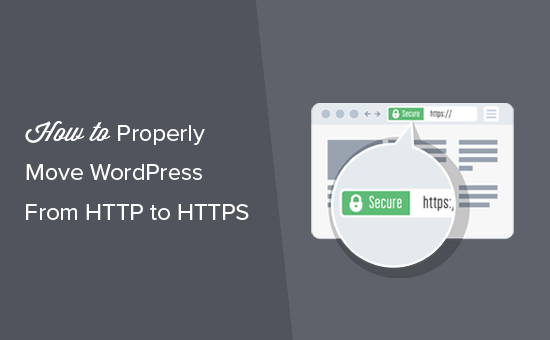
He aquí un breve resumen de los temas que trataremos en este artículo:
- What Is HTTPS?
- Why Do You Need HTTPS and SSL?
- Requirements for Using HTTPS/SSL on a WordPress Site
- Setting Up WordPress to Use SSL and HTTPS
- Method 1: Setup SSL/HTTPS in WordPress Using a Plugin
- Method 2: Set Up SSL/HTTPS in WordPress Manually
- Submit Your HTTPS Site to Google Search Console
- Bonus Resources
- Video Tutorial
¿Qué es HTTPS?
HTTPS, o HTTP seguro, es un método de encriptación que asegura la conexión entre el navegador de un usuario y su servidor. Esta seguridad añadida hace que sea mucho más difícil para los hackers interceptar los datos que se transfieren.
Todos los días, la gente comparte datos personales con sitios web, ya sea para realizar compras o simplemente para iniciar sesión. Hemos visto de primera mano lo crucial que es proteger este tipo de intercambio de datos.
Para garantizar la seguridad de los datos, es necesario establecer una conexión segura.
Aquí es donde SSL y HTTPS entran en juego.
Cada sitio web recibe un certificado SSL único para su identificación. Si un servidor intenta utilizar HTTPS sin un certificado válido o si el certificado no coincide, la mayoría de los navegadores modernos avisarán a los usuarios y les aconsejarán que no continúen.
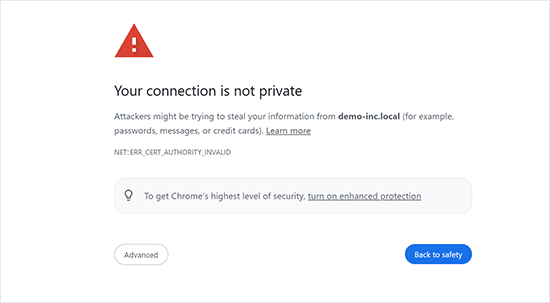
Ahora, usted podría preguntarse por qué es necesario mover su sitio de WordPress de HTTP a HTTPS, especialmente si se trata de un simple blog o sitio web de pequeñas empresas que no procesan pagos.
¿Por qué necesita HTTPS y SSL?
Ya en 2018, Google anunció una iniciativa para impulsar la seguridad web instando a los propietarios de sitios a cambiar de HTTP a HTTPS. Para apoyar este movimiento, su navegador Chrome comenzó a marcar todos los sitios web sin un certificado SSL como “No seguros”.
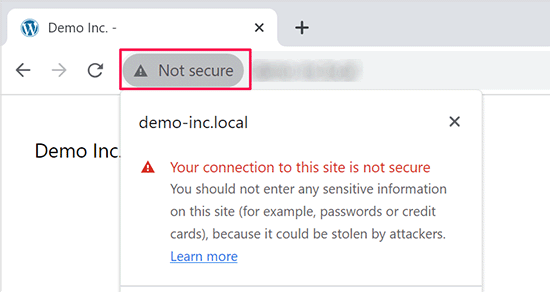
Google también mencionó que los sitios con SSL recibirían ventajas de SEO y podrían alcanzar clasificaciones de búsqueda más altas que los sitios no seguros. Este anuncio empujó a muchos propietarios de sitios a cambiar a HTTPS.
Cuando se lanzó la advertencia “No seguro”, Chrome empezó a marcar los sitios HTTP. Por ejemplo, visitar un sitio HTTP en modo incógnito o rellenar un formulario de contacto en un sitio HTTP activa la advertencia, marcándolo como inseguro.
Cuando los visitantes ven esta advertencia, pueden llevarse una impresión negativa de su sitio o negocio.
Por este motivo, todos los sitios web deben realizar la transición a HTTPS e instalar SSL lo antes posible.
Además, SSL es imprescindible si desea aceptar pagos en línea en su sitio de comercio electrónico.
Los proveedores de pago como Stripe, PayPal Pro y Authorize.Net requieren una conexión de pago segura.
Nos aseguramos de que nuestros propios sitios utilicen SSL, incluyendo WPBeginner, OptinMonster, WPForms y MonsterInsights.
Requisitos para utilizar HTTPS/SSL en un sitio de WordPress
Los requisitos para utilizar SSL en WordPress no son muy elevados. Basta con adquirir un certificado SSL, y puede que ya lo tengas de forma gratuita.
Las mejores empresas de alojamiento de WordPress ofrecen certificados SSL gratuitos a todos sus usuarios:
Para obtener más información, consulte nuestra guía sobre cómo obtener un certificado SSL gratuito para su sitio web en WordPress.
Si su empresa de alojamiento no ofrece un certificado SSL gratuito, tendrá que adquirir uno.
Recomendamos Domain.com porque ofrece la mejor oferta de certificados SSL normales y comodín.
Al comprarles un certificado SSL, también obtendrá un sello TrustLogo para su sitio web. Cada certificado SSL tiene una garantía de seguridad mínima de 10.000 dólares. Los precios empiezan en 33 $ anuales y los certificados SSL se renuevan automáticamente.
Una vez que haya adquirido un certificado SSL, deberá solicitar a su proveedor de alojamiento que se lo instale.
¿Necesita ayuda para configurar SSL y pasar a HTTPS?
Si no tiene tiempo de configurar SSL, nuestro servicioPremium WordPress Support está aquí para ayudarle. Podemos encargarnos de todo el proceso por ti, garantizando que tu sitio sea seguro y esté listo para recibir visitas.
- Tasa única
- Plazos de entrega rápidos
- Disponible 24 horas al día, 7 días a la semana
Puede estar tranquilo sabiendo que su sitio está en manos expertas. Póngase en contacto con nosotros hoy mismo para una instalación SSL y migración HTTPS sin problemas.
Establecer el uso de SSL y HTTPS en WordPress
Después de activar un certificado SSL para su nombre de dominio, tendrá que configurar WordPress para utilizar los protocolos SSL y HTTP en su sitio web.
Le mostraremos dos métodos para hacerlo, y podrá elegir el que mejor se adapte a sus necesidades.
Método 1: Configurar SSL/HTTPS en WordPress mediante un plugin
Este método es más sencillo y se recomienda a los principiantes.
En primer lugar, debe instalar y activar el plugin Really Simple SSL. Para más detalles, consulta nuestra guía paso a paso sobre cómo instalar un plugin de WordPress.
Tras la activación, debe visitar la página Configuración ” SSL. El plugin detectará automáticamente su certificado SSL y configurará su sitio WordPress para utilizar HTTPS.
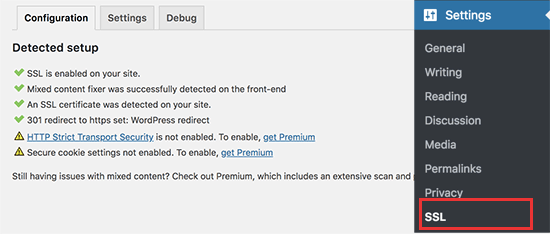
El plugin se encargará de todo, incluidos los errores de contenido mixto. Esto es lo que hace el plugin entre bastidores:
- Marcar / comprobar certificado SSL
- Establecer WordPress para usar https en URLs
- Establecer redireccionamientos de HTTP a HTTPS
- Busque URLs en su contenido que todavía se estén cargando desde fuentes HTTP inseguras e intente arreglarlas.
Nota: El plugin intenta solucionar los errores de contenido mixto utilizando una técnica de almacenamiento en búfer de salida. Esto puede tener un impacto negativo en el rendimiento, ya que reemplaza el contenido del sitio a medida que se carga la página. Este impacto sólo se ve en la primera carga de la página, y debería ser mínimo si está utilizando un plugin de almacenamiento en caché.
Aunque el plugin dice que puedes mantener SSL y desactivar el plugin de forma segura, no es 100% cierto. Tendrás que dejar el plugin activo en todo momento porque desactivarlo traerá de vuelta errores de contenido mixto. Vea nuestra revisión de Really Simple SSL para más detalles.
Método 2: Establecer SSL/HTTPS en WordPress manualmente
Este método requiere que diagnostiques los problemas manualmente y edites los archivos de WordPress. Sin embargo, es una solución permanente y de mayor rendimiento, y la estamos utilizando en WPBeginner.
Si este método le resulta difícil, debería contratar a un desarrollador de WordPress o utilizar el primer método en su lugar.
Es posible que tenga que editar el tema de WordPress y los archivos de código como parte de este método. Si no lo has hecho antes, consulta nuestra guía sobre cómo copiar y pegar fragmentos de código en WordPress.
En primer lugar, debe visitar la página Configuración ” General. Desde aquí, debe actualizar los campos de dirección URL de WordPress y del sitio sustituyendo http por https.
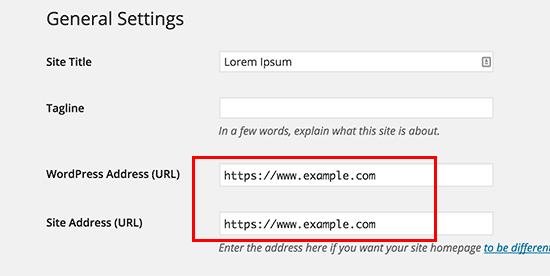
No olvides hacer clic en el botón “Guardar cambios” para establecer los ajustes.
Una vez guardados los ajustes, WordPress le desconectará y le pedirá que vuelva a conectarse.
A continuación, debe establecer los redireccionamientos de WordPress de HTTP a HTTPS añadiendo el siguiente código a su archivo .htaccess:
1 2 3 4 5 | <IfModule mod_rewrite.c>RewriteEngine OnRewriteCond %{HTTPS} offRewriteRule ^(.*)$ https://%{HTTP_HOST}%{REQUEST_URI} [L,R=301]</IfModule> |
Si utiliza servidores NGINX, tendrá que añadir el siguiente código para redirigir de HTTP a HTTPS en su archivo de configuración:
1 2 3 4 5 | server {listen 80;server_name example.com www.example.com;return 301 https://example.com$request_uri;} |
No olvide sustituir ejemplo.com por su nombre de dominio.
Siguiendo estos pasos, evitará el error de WordPress HTTPS not working porque ahora WordPress cargará todo su sitio web usando HTTPS.
Si desea forzar SSL y HTTPS en su área de administrador de WordPress o páginas de acceso, necesita configurar SSL en el archivo wp-config.php.
Añada el siguiente código encima de la línea “¡Eso es todo, deje de editar!” en su archivo wp-config.php:
1 | define('FORCE_SSL_ADMIN', true); |
Esta línea permite a WordPress forzar SSL / HTTPs en el área de administrador de WordPress. También funciona en redes multisitio de WordPress.
Una vez hecho esto, su sitio web estará totalmente establecido para utilizar SSL / HTTPS, pero seguirá encontrando errores de contenido mixto.
Estos errores son causados por fuentes (imágenes, scripts u hojas de estilos) que todavía se cargan utilizando el protocolo HTTP inseguro en las URL. Si ese es el caso, entonces no podrá ver un icono de candado seguro en la barra de direcciones de su sitio web.
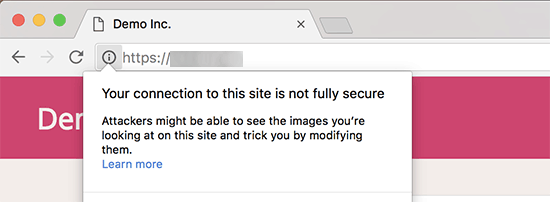
Muchos navegadores modernos bloquean automáticamente los scripts y recursos no seguros.
Es posible que vea un icono de candado pero con un aviso acerca de ello en la barra de direcciones de su navegador.
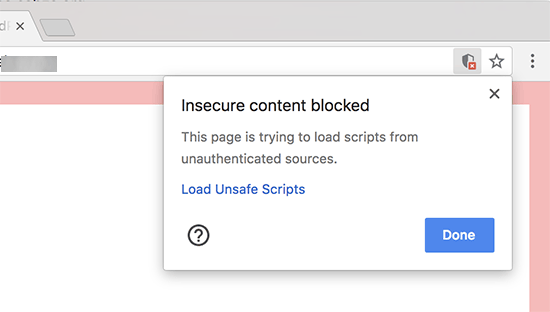
Puede averiguar qué contenidos se sirven a través de un protocolo inseguro utilizando la herramienta Inspeccionar.
El error de contenido mixto se mostrará como una advertencia en la consola con detalles para cada elemento / artículo de contenido mixto.
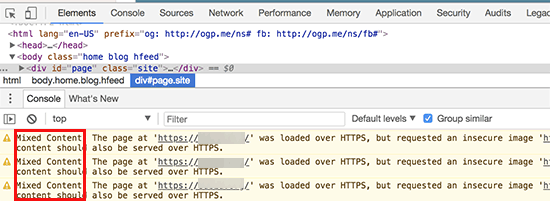
Observará que la mayoría de las URL son imágenes, iframes y galerías de imágenes, mientras que algunas son scripts y hojas de estilos cargadas por sus plugins y temas de WordPress.
Corrección de contenido mixto en la base de datos de WordPress
La mayoría de las URL incorrectas serán imágenes, archivos, incrustaciones y otros datos almacenados en la base de datos de WordPress. Vamos a corregirlos primero.
Lo mejor sería que encontrara en la base de datos todas las menciones de la URL de su antiguo sitio web que empiecen por HTTP y las sustituyera por la URL de su nuevo sitio web que empiece por HTTPS.
Puedes hacerlo fácilmente instalando y activando el plugin Search & Replace Everything. Para más detalles, consulta nuestra guía paso a paso sobre cómo instalar un plugin de WordPress.
Una vez activado, debe visitar la página Herramientas ” WP Search & Replace. En el campo ‘Buscar’, tienes que añadir la URL de tu sitio web con http. A continuación, añada la URL de su sitio web con https en el campo “Reemplazar”.
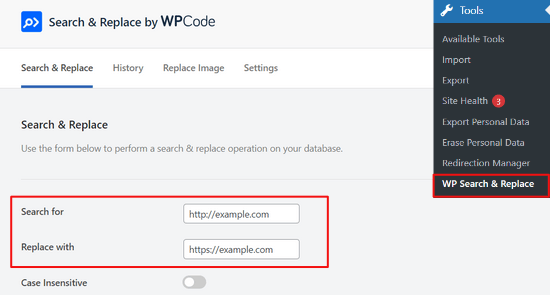
Debajo verá todas las tablas de su base de datos de WordPress.
Debe seleccionarlos todos para realizar una comprobación exhaustiva.
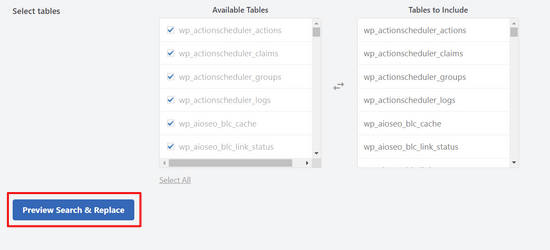
A continuación, haz clic en el botón “Vista previa de Buscar y reemplazar” para ver todos los cambios que realizará el complemento.
Por último, haga clic en el botón “Reemplazar todo”.
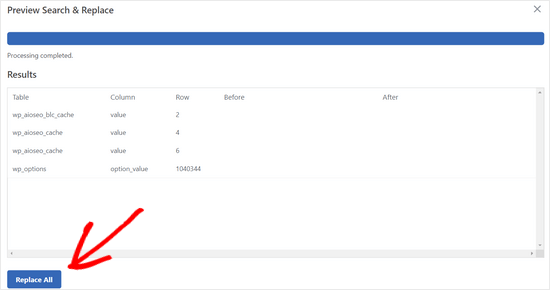
El plugin buscará en su base de datos de WordPress las URLs que empiecen por http y las sustituirá por URLs https seguras. Puede tardar un poco, dependiendo del tamaño de la base de datos de WordPress.
Corrección de errores de contenido mixto en el tema de WordPress
Otro culpable común de los errores de contenido mixto es tu tema de WordPress. Cualquier tema de WordPress decente que siga los estándares de código de WordPress no causará este problema / conflicto / incidencia.
En primer lugar, tendrá que utilizar la herramienta Inspeccionar de su navegador para encontrar los recursos y saber desde dónde se están cargando.
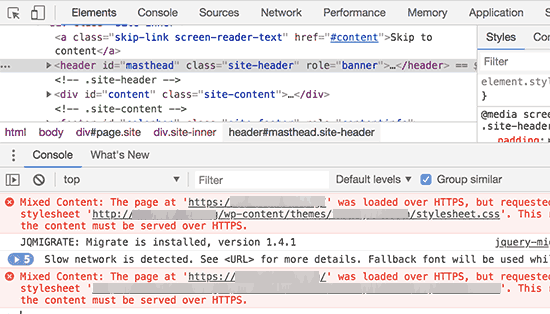
Después, tendrá que encontrarlos en su tema de WordPress y sustituirlos por https. Esto será un poco difícil para la mayoría de los principiantes, ya que no será capaz de ver qué archivos de tema contienen estas URL.
Corrección de errores de contenido mixto causados por plugins
Algunos recursos de contenido mixto serán cargados por plugins de WordPress. Cualquier plugin de WordPress que siga los estándares de código de WordPress no causará errores de contenido mixto.
No recomendamos editar los archivos de los plugins de WordPress. En su lugar, debe ponerse en contacto con el autor del plugin y hacérselo saber. Si no responden o no se ha podido corregir el problema, busque una alternativa adecuada.
Nota: Si, por alguna razón, sigue encontrando un error de contenido mixto, le recomendamos que utilice temporalmente el plugin Really Simple SSL para que sus usuarios no se vean afectados mientras corrige el problema en un sitio web de prueba o contrata a un desarrollador.
Envíe su sitio HTTPS a Google Search Console
Los motores de búsqueda como Google consideran que https y http son dos sitios web diferentes. Para evitar cualquier problema / conflicto / incidencia de SEO, deberá informar a Google de que su sitio web se ha trasladado.
Para ello, sólo tiene que acceder a su cuenta de Google Search Console y hacer clic en el botón “Añadir propiedad”.

Aparecerá una ventana emergente en la que deberá añadir la nueva dirección https de su sitio web.
Existen dos métodos de verificación de sitios: nombre de dominio o prefijo URL. Recomendamos el método del prefijo URL porque es más flexible.
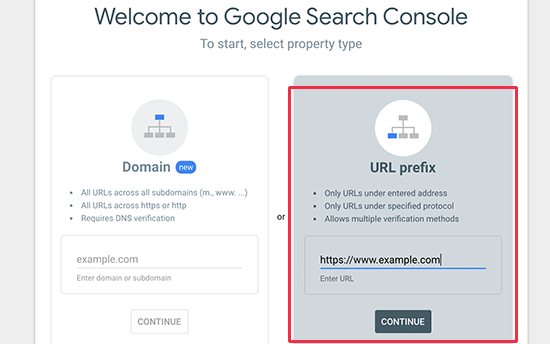
A continuación, Google le pedirá que verifique la propiedad de su sitio web.
Hay varias formas de hacerlo. Seleccione cualquier método y obtendrá instrucciones para verificar su sitio. Le recomendamos que utilice el método de etiquetas HTML.
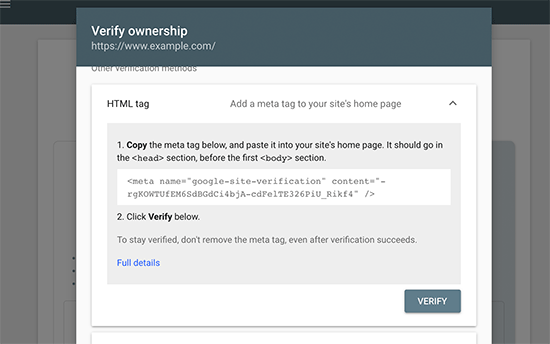
Ahora verá un fragmento de código HTML que deberá añadir a la sección encabezado de su sitio web WordPress.
Añadir código de verificación de Search Console usando All in One SEO
En primer lugar, instale y active el plugin All in One SEO para WordPress. Para más detalles, consulte nuestro tutorial sobre cómo instalar un plugin de WordPress.
Nota: También existe una versión gratuita de All in One SEO que puedes probar.
Una vez activado, ve a la página Todo en uno SEO ” Configuración general y haz clic en Google Search Console.
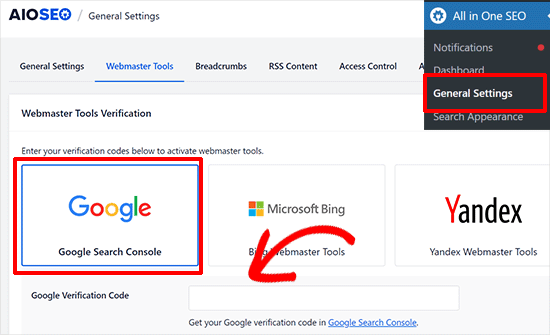
A continuación, debe añadir el código de verificación que copió anteriormente del sitio web de Google Search Console.
No olvides hacer clic en el botón “Guardar cambios” para establecer los ajustes.
A continuación, vuelve a la pestaña Google Search Console y haz clic en el botón “Verificar”.
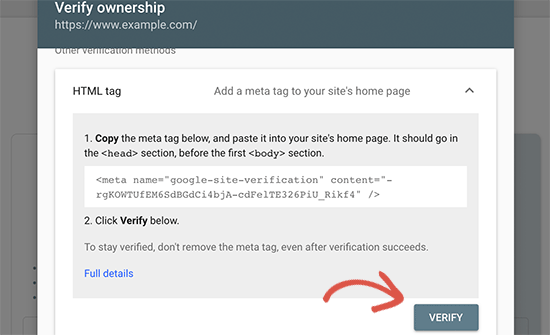
Una vez verificado su sitio, Google mostrará aquí los informes de su consola de búsqueda.
También debe asegurarse de que tanto la versión https como la http están añadidas a su Search Console.
Esto indica a Google que desea que la versión https de su sitio web sea tratada como la versión principal. Combinado con los redireccionamientos 301 configurados anteriormente, Google transferirá sus clasificaciones de búsqueda a la versión https de su sitio web, y lo más probable es que vea mejoras en sus clasificaciones de búsqueda.
Recursos adicionales
A continuación se indican algunos recursos adicionales que pueden ayudarle a solucionar problemas comunes de WordPress por su cuenta y a aprender más sobre WordPress:
- Cómo corregir problemas comunes de SSL en WordPress (Guía para principiantes)
- Los errores más comunes de WordPress y cómo corregirlos
- TLS vs SSL: ¿Qué protocolo debería utilizar para WordPress?
- Cómo corregir el error de conexión segura en WordPress
Tutorial en vídeo
Esperamos que este artículo te haya ayudado a añadir HTTPS y SSL en WordPress. Puede que también quieras ver nuestra guía definitiva de seguridad en WordPress con instrucciones paso a paso para mantener tu sitio WordPress seguro o cómo renovar tu certificado SSL.
If you liked this article, then please subscribe to our YouTube Channel for WordPress video tutorials. You can also find us on Twitter and Facebook.




Kevin Bollhorst
Thank you for this informative article. I am looking into switching my blog to SSL. The web host provider is Bluehost and I am using the free Cloudflare CDN Service. I have one question. Will Cloudflare’s free service support Bluehost’s Free SSL certificate?
WPBeginner Support
Hi Kevin,
Please contact Bluehost or Cloudflare support, you may need additional configuration for SSL to work with your free Cloudflare CDN.
Admin
Moritz Steiger
I followed these instructions and now it has screwed my site, nothing works. I now get the ‘White screen of death’ my host won’t help as they say it is a coding error and I am left in limbo.
WPBeginner Support
Hi Moritz,
We are sorry to hear that. Please undo the steps you took while following the tutorial one by one and that should fix your site to normal.
Admin
Chandra
Hi,
Thank for you for such an detailed article on a very hot topic.
I followed manual steps but got mixed content error. And seems because of this I’m not able to see WP login page. I tried clearing cache on dreamhost but message displayed is “Unable to connect to CloudFlare”.
I’m using Dreamhost and Cloudflare is enabled.
Could you please help or need more details to fix the issue? Do you also offer paid service to secure another site of my mine?
Thank You.
WPBeginner Support
Hi Chandra,
Please review your Cloudflare settings.
Admin
Richard
Hi,
Just followed through the manual procedure without problems – Thanks!
However, I’ve noticed that If I type the old http:// address into the browser for any page except for the homepage then the old http:// page loads.
Then when I click a link to another page it goes to a https:// page is this normal?
Does it indicate a problem with the redirect?
WPBeginner Support
Hi Richard,
No it is not. Most likely the redirects in your .htaccess file are not working. Try copying the code and adding it to your .htaccess file again and see if this resolves the issue.
Admin
Richard
Hi,
Fixed It thanks. I’d originally inserted the Code at the end of the htaccess file. Moved It Up to before the WP section and everthing now works correctly.
Thanks for your help and for the concise guide. I’d been putting this off for a while.
Daniel
With regard to the last step in Google Console, on the “Change of Address” page, I am getting a “no available sites” message, but I have double-checked that my http and https versions are verified. When I click on “add it now” I’m just getting verification information. What do I do?
Emily Randall
I just installed a LetsEncrypt cert on my website, and I’m getting a bunch of insecure content errors that shouldn’t be happening. Although the theme is using get_template_directory_uri() to load its styles and scripts, those styles and scripts are still being loaded via http, not https. Even if I hard-code the https url in the function to load the styles/scripts, they’re loaded via http.
Do you have any idea what’s happening here? As far as I can tell, everything is set up properly, but it’s not working.
WPBeginner Support
Hi Emily,
Try clearing WordPress cache.
Admin
skaur
Hi,
I have purchase SSL and configured by my hosting. It shows https in url. when I do https under General settings in wordpress admin area, my website goes down, only homepage and after it I am not able to login the admin area too. I added the code in htaccess file too with https under settings.
Could you help me with this?
Thanks
stan
https://support.google.com/webmasters/answer/83106 says that
Note: The tool does not currently support the following kinds of site moves: subdomain name changes, protocol changes (from HTTP to HTTPS), or path-only changes.
WPBeginner Support
Hi Stan,
Yes, we are aware of that. However, we still recommend taking this step. It is safe and will not have any negative impact on your site.
Admin
Lindsey Bell
I use Bluehost for web hosting and just set up my wordpress site with their free SSL certificate through the Bluehost page. There was a page on the Bluehost site to activate it for my WordPress site. Now, it appears that my site is already set up with the https. Do I still need to install the plug in, or is mine already taken care of? Thanks so much for the help!
WPBeginner Support
Hi Lindsey,
You still need to install the plugin.
Admin
Farukh hussain
Hi,
I was founding this issue and you just uploaded this article. Thanks alot.
Can you please help? I did not change my primary site on search console. I added a new property with https and then created a set for all of them. Will it work fine for ranking or I need to follow your instructions only???
WPBeginner Support
Hi Farukh,
Adding HTTPS property and then redirecting users from HTTP to HTTPs will work fine.
Admin
Paula Jones
So I have to purchase a dedicated IP address to use the free SSL certificate?
WPBeginner Support
Hi Paula,
No, you don’t need a dedicated IP address to use free SSL certificate.
Admin
Chris
I don’t understand why a redirect is still necessary once the hosting service installs the certificate for the site. I’m assuming that a WordPress site initially configured with the HTTPS protocol does not require a redirect. Is it a matter of registering a domain with or without the proper protocol?
James Katt
The problem of buying an SSL certificate and having it installed is that you will need to also purchase a fixed IP address from your Web Host. This is an additional yearly cost on top of the yearly cost of the SSL Certificate. For each website you create you have to buy an SSL certificate and a fixed IP address. This will add up tremendously the more websites you have.
Because of this, I prefer creating websites on hosts that Automatically give you a Free SSL certificate. These days, the ones that don’t simply want to gouge you for money.
Rupam krishna Bharali
Can the internal configuration of SSL and HTTPS help to reduce the SSL loading time during a request? When I tested my website with SSL enabled and it took about 455 ms to load “the SSL separately”, but when I disabled the SSL total loading time decreased to 1.3s. So two question I want to ask you guys,
1. Can I go without an SSL just because I have a Simple blog, no commercial stuff, and web payments?
2. Can the configuration of SSL internally with the help of .htaccess file reduce the loading time of SSL?
WPBeginner Support
Hi Rupam,
1. You can but soon Google will start warning users about websites not using HTTPs, this would affect your website’s traffic.
2. Yes, it can. You can also try to avoid plugins to fix mixed content issues. We have noticed that often such plugins increase page load time significantly.
Admin
Adeshewa
Could someone help please, I followed the direction of the first one all my pages are secure except for one on the menu. Whenever I clicked on it as a customer it says your connection to this website isn’t encrypted.
Troy
Not sure if you got this fixed yet, but I was having the same issue. I found that using the SSL Insecure Content Fixer plugin corrected it. Worth a shot!
Shyam
Hi wpbeginner,
My website did not have ssl certificate. I changed the http to https now it is showing ssl not enabled. What do I do?
Zohaib Sadique
If you are working in WordPress then install the plugin named “really simple SSL” to force up your SSL. I hope you will get the idea. Thanks for reading.
Erin
Thank you!! Finally I have my SSL certificate recognised by wordpress and I couldn’t have done it without the info provided here. So a BIG thanks for helping me out!
Farrukh Ghafoor
I have added the code into the .htaccess file but when I refresh my page in WordPress it comes up with a “Your connection is not private” message. I have to click on “Back to safety” and the icon does not appear in the website url. Please help me to fix this. Thanks
Marco
Where do you install WordPress? public_html or private_html ?
WPBeginner Support
Hi Marco,
You need to install WordPress in public_html folder.
Admin
Cecilia W
I followed the first step, adding the https: to the website name and immediately the webpage redirected me to a sit not secure error prompt and now I can’t access my dashboard at all to finish the process or do any bug fixes. How do I reverse the first step?
Mark Lewis
Thank you for this helpful article
Tammy
I have used your site for a resource for a long time. Therefore, I was confident when I followed the directions in this article–to the letter. I used it on a client’s site. Which seemed to work perfectly. Then my own site. However, now I am locked out of both sites. I have a backup of them using the WP all-in-one migration plugin, but no way to access the dashboard.
One site says too many redirects. Even when going to an incognito window or a browser where I’ve recently deleted all history, it still says delete all cookies. The other site says can’t connect to server.
Any suggestions for me? I am pretty screwed at this point.
Thanks,
Tammy
WPBeginner Support
Hi Tammy,
Please see our article on how to fix too many redirects issue in WordPress.
Admin
Sukka
Does my backlinks gets lost after change. Kindly some one clears it to me.
As when I checked my website through semrush https is showing 0 backlinks but I actually have 1000+ backlinks.
Please someone guide.
Thanks.
dan
Why doesn’t the .htaccess stuff for Apache contain the 301 redirect information?
Divine
This was really helpful. Though after doing it, it showed 404 in most pages but when I updated the paramalink…it was solved
Pipy
Please, I am looking for some ways that I can do to secure the WordPress website from hackers and becoming a secure site. Suggest please
WPBeginner Support
Please see our ultimate WordPress security guide.
Admin
Ravi
Hey wpbeginner team why you guys are not using ssl certificate.?
Waiting for your answer.
Reo
Let me answer that. WPBeginner no need to use SSL because they don’t have a login/signup page and ecommerce.
SaifZiya
But, hasn’t Google now announced that having an SSL certificate can boost your rankings in SERPS?
Cristi Adam
Thank you for info man, great article, it really fixed my issue
Amar Patel
after adding ‘s’ to the WordPress URL and site URL redirection is working properly…I removed the ‘s’ and put redirection code in my .htaccess then browser saying error too much redirection.
If i go for first option that will be fine or not ?….how can in know my redirection working properly ?
Nalin
Hi,
Is it necessary to include the code in htaccess? I am using wordpress and checked with whynopadluck and manually changed the link of the images with non https link. After that, it shows all items are secure. Do I still need to update htaccess? Doesn’t WordPress redirect http to https by itself?
Mottaqi
If I install a new WordPress installation for a new site should I do all of these???
Abiola Oyeniyi
Cloudflare SSL or Let’s Encrypt which one is the best. I had to switch to Cloudflare SSL
Mukesh Patel
If you are using cloudflare than you can easily switch your site to HTTPS. If you are using free plan then their are no option available for use custom SSL. If you install Let’s Encrypt SSL on origin server, Even after that browser will show Cloudflare SSL.
Richard
Very helpful article. However, I am wondering if I would still be required to update the .htaccess file (per your example) if I am using the plugin: “Really Simple SSL” that you recommended in a newer article. (Also, would this plugin take care of changing the WP General Settings?)
Thanks!
James
We completed step 1 and now we cannot login to our wordpress to do step 2 or 3. And the only page that works on our site it the home page. All other pages try to pull up as https and gives an error. We have to manually take the s out so it’s http before the page will show.
We’ve undone the first step and still cannot login. We are dead in the water here.
Jerome Williams
Worked great. For people with self-signed certs yeah, you will get an error. But if you get that warning, that means you followed this tutorial correctly! All you have to do now is resolve your SSL signing issue and you’re set.
Bhupesh Pant
Hi After making the above changes I am not able to open my site, I am not even able to login to my wp- admin page to revert https to http please help.
Enyel Cuadro
(GoDaddy)
define(‘FORCE_SSL_ADMIN’, true);
after adding this line then reload the website, I got error that “your connection is not private”. I am using self-signed certificate. Please help how to setup https using self-signed certificate.
Kimball
Do a view source on your page. See anything that starts with http:// like css, js, or image files? Those will have to be changed in your content or template.
Mukesh Patel
Do not use self-signed-certificate. You can choose Let’s Encrypt SSL, Free Comodo Certificate or Cloudflare SSL. These all are free of cost.
Ali O
I know that WPBeginner is great, but you exceeded my expectations and totally saved my week today with this how-to guide! Love you guys!
Red Strivens
Remember to change the Port as well !!!!
Mari-Lyn
Thank you for the simple explanation of making a site ssl compliant.
Bala krishna reddy mogiligundla
Sir i have stuck in a problem i hope you could help , i have a hosting which is worth $300 in godaddy i have added one website and bought an ssl for that …again after some days i have added secondary site avantsolutions.ca to same hosting . i have been told that i cannot buy additional ssl to this hosting and suggested me to buy one unified ssl which costs around 350$ .Please dont mind me saying this but i have already spent alot and cant afford that ..what other options do i have
WPBeginner Support
Hello Bala Krishna,
Please try to resolve it with your hosting provider through live chat or phone support. If you have purchased a hosting plan that doesn’t meet your needs, then you can ask them for a refund. Most hosting companies have some sort of refund policy which is usually valid during the first 30 days of signup.
Admin
Lydia
Hi, my host offers the Let’s encrypt so I have gone that route, as this is all new I have created a new site to practice on which i set up the lets encrypt shared ssl. Now I am trying to move it from http to https I did install the simple ssl plugin but it did not find my ssl certificate, not sure if it is set to work with shared lets encrypt so, i found another plugin called wp encrypt which is designed specifically for the shared lets encrypt but i am not able to get it to connect the way it instructs. I have checked my outgoing connections and they are clear. Would appreciate any help in working this process out, so I can get started on the shift. Thanks
Max
Followed the instructions and basically bricked my website.
between 404 errors, database connection errors and more and more errors… that 301 redirect causes way too many problems.
Brian Luff
Thanks for the article, which is interesting and informative. There’s one problem it doesn’t mention, and no-one else has commented so I wonder if I’m missing something.
I bought a third-party SSL certificate from the hosting company and switched to HTTPS. After making the .htaccess changes, everything worked fine, except…
None of the pages get a green padlock. Instead, there’s an info link that says the pages are ‘partially secure’.
I checked with the hosting company, and they said I had to change every internal link to HTTPS, and the URL of every image likewise. If I don’t do that, then no green padlock.
Manually making all those changes would take me months even if I worked 8 days per week, 25 hours per day. If I’d known that at the outset, I would not have made the change to SSL/HTTPS in the first place.
Is what I’m being told correct? If so, is there any (even semi-)automated way of updating all the links in the site?
WPBeginner Support
Hi Brian,
You can install Really Simple SSL plugin and it will take care of partially insecure links on your website.
Admin
Brian Luff
Many thanks for that, I’ll remember it for next time (I have a personal blog I’m thinking about moving from .com to .org). In this case I already bit the bullet. It turns out I was exaggerating but it did take me several hours to go through 200 posts and 70 pages manually changing all the internal links and the image references. At the end of all that, there was still no green padlock, but I found the last few instances using a useful (free) tool (which may or may not be a useful adjunct to your plugin). I now have another question, but I’ll post it separately for clarity. Thanks again for responding.
WPBeginner Support
Hi Brian,
Glad to know that you fixed it
Felix
Hi Brian,
There is another ultimate solution for that problem. Try to make Backup of MySQL database of your site manually by the procedure:
https://www.wpbeginner.com/beginners-guide/how-to-make-a-wordpress-database-backup-manually/
OR.
Almost any hosting provider has an option such as “download MySQL database” or “dump MySQL database”. You will download .sql file. After that open that .sql file in text editor such notepad++ and try the find-replace function to find “http” and replace it by “https”. It will take a second.
hiren
hii,
I does the changes as above in my site but now it is getting problem ” Error establishing a database connection”
so i’ve no idea where to do changes .
pls help. thanks in advance.
Lisbeth
What to do if I want to revert back from https to http?
There aren’t many guides on this one. Please help.
Tom W
A quick update – there is a free plugin called Really Simple SSL that you can download, activate, and it works great!
Many thanks to the author.
Jason
I tried this and had a problem. I switched from a basic html/htm site to wordpress so my .htaccess has a lot of 301 redirects. No I’ve bought an SSL In the current setup if I add RewriteRule ^(.*)$ to the .htaccess file then if anybody attempts to browse the site they get “the webpage has a redirect loop” error. So I’ve had to take out that line of code. Anything I can do?
Avinash Kumar
I am using cloudflare for https and want to know how to display “secure lock sign” before the https:// and I also want to know why you are not using https ?
hiren
Just install a Really simple SSL plugin and active it. and change in the yor site general setting it is Setting >> General >> https://example.com
Mukesh Patel
Hello Avinash Kumar.
wpbeginner don’t use HTTPS because they don’t have any login, signup page and also don’t sale anything.
WPBeginner Support
Hi Avinash and Mukesh,
Actually, we have moved to HTTPS recently.
Admin
Bart Nash
When configuring the SSL certificate, is it better to add the www to https:// or leave off the www when setting up a new wp site.
WPBeginner Support
Hi Bart,
See our guide on www vs non-www.
Admin
tim
Reason when I complete all the steps. Thank you for your article! I was wondering though, my website recently has suffered some problems with.